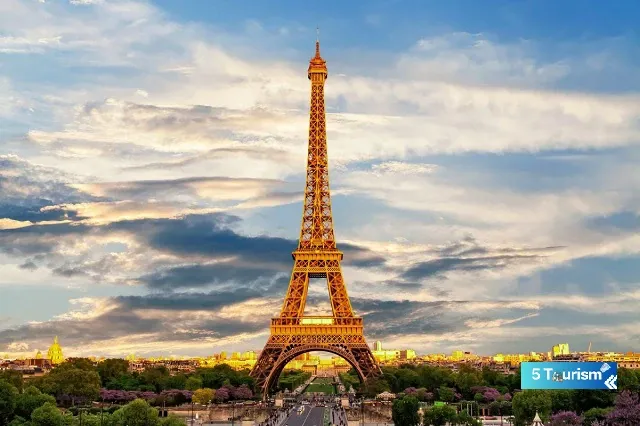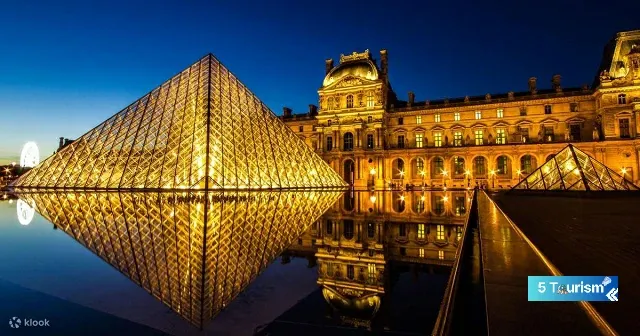Discovering France: A Comprehensive Guide to Tourist Attractions, Culture, and Cuisine
Introduction:
France stands out as one of the most renowned tourist destinations globally, blending rich history, unique culture, and breathtaking landscapes. In this article, we will explore the key tourist attractions in France and take a closer look at some of the finest hotels and transportation options.
Tourist Attractions:
1. Paris - Eiffel Tower: A symbol of France and one of the world's most iconic landmarks
 |
| Eiffel Tower |
The Eiffel Tower is one of the most prominent landmarks globally and is considered an iconic symbol of the French capital, Paris, and French culture in general. Here are some exciting facts about the Eiffel Tower:
1. Construction History:
- The construction of the Eiffel Tower began in 1887 and was completed in 1889 to celebrate the centennial of the French Revolution.
- It was designed by the engineer Gustave Eiffel and was then considered the tallest man-made structure in the world.
2. Location:
- The Eiffel Tower is located in the Champ de Mars Park in Paris, on the right bank of the Seine River.
3. Height:
- The Eiffel Tower stands at an approximate height of 324 meters (1,063 feet).
4. Structure and Materials:
- The tower consists of around 18,038 iron pieces and weighs approximately 7,300 tons.
- It is known for its intricate engineering design, including arches and interlocking sections.
5. Visitors to the Tower:
- The Eiffel Tower welcomes nearly 7 million visitors annually, making it one of the most visited tourist sites globally.
6. Activities at the Tower:
- The tower offers restaurants and cafes on its upper floors, allowing visitors to enjoy breathtaking views of Paris.
7. Lighting of the Eiffel Tower:
- The tower is illuminated with bright lights during the night, and there is a sparkling light show at specific hours, enhancing its tourist appeal.
8. Eiffel Tower Events:
- Throughout its history, the Eiffel Tower has hosted various significant events and served as a location for film shoots and artistic works.
The Eiffel Tower is not just a tourist attraction but also a symbol of art and engineering, remaining one of the most attractive places globally.
2. Louvre Museum: Home to an extensive collection of international artworks
 |
| Louvre Museum |
Information about the Louvre Museum:
1. Foundation History:
- The Louvre Museum in Paris was opened in 1793, initially serving as a royal palace before transforming into an art museum.
2. Location:
- Situated on the right bank of the Seine River in the heart of Paris, the Louvre is one of the largest art museums globally.
3. Artistic Collection:
- The Louvre houses an extensive collection of artworks covering various periods, from ancient times to modern eras.
4. Mona Lisa Painting:
- The Louvre is renowned for housing Leonardo da Vinci's painting "Mona Lisa," one of the most famous artworks in art history.
5. Building Structure:
- The Louvre's building comprises Roman ruins, a medieval fortress, and modern additions, featuring unique artistic and architectural designs.
6. Visitors and Artworks:
- The Louvre welcomes millions of visitors annually and boasts over 380,000 works of art, including sculptures, paintings, and artifacts.
7. Glass Pyramid Courtyard:
- The glass pyramid in the museum's courtyard is an iconic architectural and artistic landmark.
8. Artistic Sections:
- The museum is divided into different artistic sections, such as ancient art, Islamic art, sculpture, and decorative arts.
9. Events and Exhibitions:
- The Louvre hosts regular events and art exhibitions, enhancing the visitor experience.
10. Visitor Services:
- The museum provides visitor services, including guided tours, workshops, and souvenir shops.
The Louvre Museum is an essential destination for art and history enthusiasts, representing an integral part of French cultural heritage.
3. Acropolis: The famous temple in Nice, offering stunning views of the city
 |
| Acropolis |
The Acropolis:
1. Location:
- The Acropolis is a collection of ancient temples situated atop a hill in the heart of Athens, Greece.
2. History:
- The construction of the Acropolis dates back to the 5th century BCE, initiated during the rule of the Athenian statesman Pericles.
3. Original Purpose:
- The primary purpose of building the Acropolis was to honor Greek gods, particularly Athena, the goddess of wisdom and war.
4. Architecture:
- The site features classical Greek architecture, and the temples were constructed using white marble.
5. Temples:
- One of the most prominent temples on the Acropolis is the Parthenon, built to honor Athena Parthenos, the goddess of wisdom.
6. Marble Sculptures and Inscriptions:
- The Acropolis had marble statues and inscriptions depicting Greek art and mythology.
7. Ottoman Attack:
- In the 17th century, some of the temples were destroyed during the Ottoman attack on Athens.
8. Preservation and Restoration:
- Extensive preservation and restoration efforts have been made over the centuries to protect the Acropolis, preserving its historical significance.
9. Visitors and Tourist Attraction:
- The Acropolis stands as one of the most significant tourist attractions in Greece, attracting millions of visitors annually.
10. Acropolis Museum:
- The site includes the Acropolis Museum, housing numerous archaeological pieces and exhibits related to Greek history.
The Acropolis represents a vital Greek cultural heritage, embodying artistic and engineering masterpieces from ancient times.
4. Mont Saint-Michel: A rocky island teeming with history and charm
 |
| Mont Saint |
Mont Saint-Michel:
1. Location:
- Mont Saint-Michel is a rocky island located in the bay of Saint-Michel in northern France.
2. History:
- The history of Mont Saint-Michel dates back to the Middle Ages, with construction starting in the 8th century.
3. Architectural Structure:
- The site features Gothic and Romanesque architecture, serving as a splendid example of medieval craftsmanship.
4. Original Purpose:
- Mont Saint-Michel was initially a religious site, hosting a Benedictine abbey on the island.
5. Historical Transformations:
- The site witnessed several historical transformations, including its military role during wars.
6. Temples and Churches:
- Mont Saint-Michel houses numerous temples and churches, including the Saint Michael's Church.
7. Tidal Flow:
- The site's shape changes with the ebb and flow of the tide, and it can be accessed on foot or by shuttle when the tide is favorable.
8. Visitors and Tourism:
- Mont Saint-Michel is a major tourist attraction in France, drawing thousands of visitors daily.
9. Art and Culture:
- The site hosts various artistic and cultural events throughout the year, enhancing the visitor experience.
10. Designation as a World Heritage Site:
- Mont Saint-Michel and its bay were inscribed on the UNESCO World Heritage List in 1979.
Mont Saint-Michel stands as a unique tourist landmark with a rich history and exceptional natural beauty, making it one of the magnificent destinations in France.
5. Palace of Versailles: Reflects opulence and refined French design
 |
| Palace of Versailles |
Palace of Versailles:
1. Location:
- The Palace of Versailles is located in the town of Versailles, approximately 20 kilometers west of Paris, France.
2. History:
- The construction of the Palace of Versailles began in the 17th century, initiated during the reign of King Louis XIV.
3. Architecture and Design:
- The Palace of Versailles is considered a symbol of French classical arts and exquisite design. It features marble facades and magnificent gardens.
4. Hall of Mirrors:
- The Hall of Mirrors is a significant feature of the Palace, reflecting natural light and used for hosting official events.
5. Gardens and Fountains:
- The gardens of the Palace of Versailles are extensive, incorporating artistic fountains and geometrically designed green spaces.
6. Versailles Museums:
- The Palace houses several museums, including the Museum of French History and the Museum of Arts.
7. Royal Display Hall:
- The Royal Display Hall showcases a collection of arts and luxurious furniture representing the opulent life of past eras.
8. Historical Uses:
- Throughout French history, the Palace of Versailles was used for hosting kings and served political and cultural purposes.
9. Cultural Impact of Versailles:
- The Palace of Versailles is an integral part of French cultural heritage and stands as one of the most important tourist attractions.
10. Visitors and Events:
- The Palace of Versailles attracts millions of visitors annually and is used for organizing events and art exhibitions.
The Palace of Versailles bears witness to the grand history of France and remains a luxurious tourist destination distinguished by its arts and magnificent architecture.
Luxury Hotels:
1. Ritz Paris: Among the world's most luxurious hotels, located in the heart of Paris.
2. Four Seasons Hotel George V: Combines luxury with exquisite hospitality in the French capital.
3. Le Bristol Paris: Characterized by elegant atmospheres and an excellent location in Champs-Élysées.
Transportation:
1. Trains: France's TGV train system efficiently connects major cities.
2. Metro and Buses: Public transportation makes navigating French cities easy and convenient.
3. Cars: Renting a car provides the freedom to explore picturesque rural areas and charming villages.
France, with its blend of romance, culture, and luxury, stands as one of the most captivating tourist destinations globally. If you are seeking a unique travel experience, France is your ideal destination.
